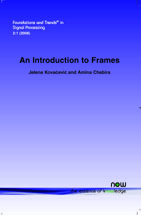An Introduction to Frames
By Jelena Kovačević, Center for Bioimage Informatics, Carnegie Mellon University, USA, j.kovacevic@ieee.org | Amina Chebira, Center for Bioimage Informatics, Carnegie Mellon University, USA, achebira@ieee.org
Abstract
This survey gives an introduction to redundant signal representations called frames. These representations have recently emerged as yet another powerful tool in the signal processing toolbox and have become popular through use in numerous applications. Our aim is to familiarize a general audience with the area, while at the same time giving a snapshot of the current state-of-the-art.
An Introduction to Frames
An Introduction to Frames is an introduction to redundant signal representations called frames. These representations have recently emerged as yet another powerful tool in the signal processing toolbox, spurred by a host of recent applications requiring some level of redundancy. It asks the question: Why and where should one use frames? And answers emphatically: Anywhere where redundancy is a must. It then goes on to discuss a host of applications that richly illustrate that answer. An Introduction to Frames is geared primarily toward engineering students and those without extensive mathematical training. It is also intended to help researchers and practitioners decide whether frames are the right tool for their application
